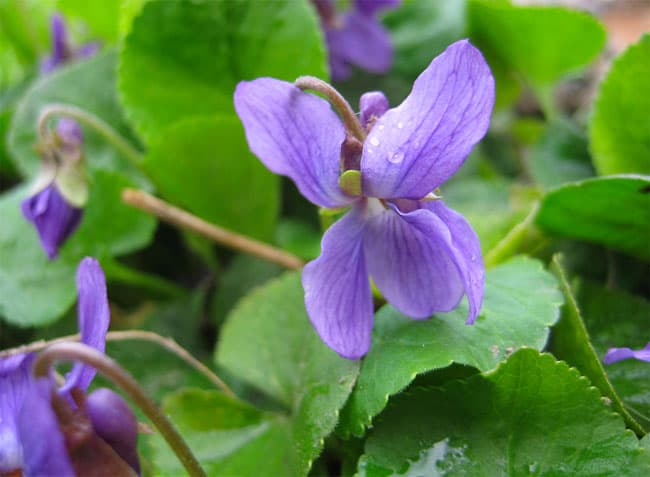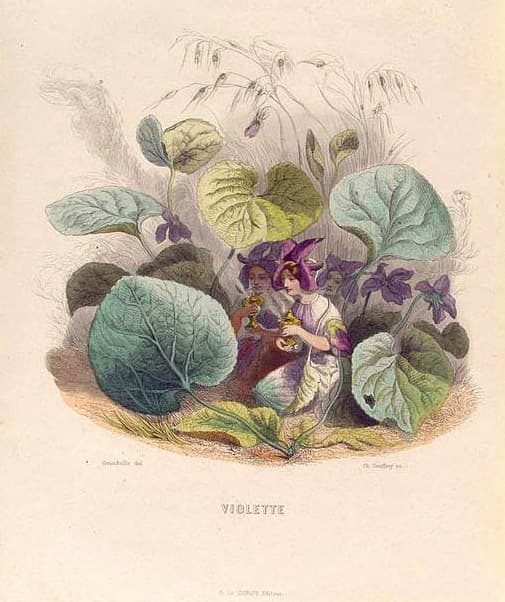A perennial herb with an excellent gentle scent. Does not require special care and is unpretentious.
Fragrant violet is used as an ornamental plant for flower beds, flower beds, borders and for cutting, it can be planted in the shade of shrubs and trees or near water bodies.
Agricultural technology.
Fragrant violet prefers cool, shady (semi-shady) places with high humidity, with fertile moist soil.
Seeds that have been stored for some time are at rest. To get good friendly seedlings, stratification of seeds is necessary for several stages. Sowing of seeds is carried out in carefully prepared moist soil, without incorporation, "under glass". The soil should be constantly moist at t up to +18 +22 °C for 2-4 weeks. Next - the period of stratification: cooling to -4 + 4 ° C for 4-6 weeks or until germination. Then it is necessary to increase t to +5 +12 °С. When the first true leaf is formed, the seedlings dive. Planted in a permanent place in August. Freshly harvested seeds are sown in spring or autumn in open ground. For the winter, young plants are covered with spruce branches.

Fragrant violet (Viola odorata) is the oldest garden crop. It has a wonderful smell, especially in the morning and evening hours. The high content of essential oil in the flowers led to its cultivation as an essential oil plant. Under natural conditions, it blooms in April-May. The technology and cultivation regimes are similar to those of the horned violet (Viola cornuta).
The most important feature of this crop is that it must be sown only with freshly harvested seeds (no later than 2 months from the moment of collection), otherwise the germination rate will be zero. In the presence of queen cells, vegetative propagation is more reliable.

* Fragrant violet - Viola odorata L.
Homeland - the European part of Russia, Crimea, the Caucasus, Western Europe, the Balkans, Asia Minor and the Mediterranean.
Perennial plant up to 15 cm tall with creeping, easy-rooting stems. Leaves on petioles, heart-shaped, blunt-toothed, up to 6 cm long, collected in dense bunches. Flowers up to 2 cm, simple or double, lilac, rarely white, have a strong pleasant aroma. It blooms in May for up to 25 days, sometimes again in autumn. Moisture-loving, but suffers from stagnant waters. It is winter-hardy, but in snowless winters it can freeze, therefore preventive cover with spruce branches is recommended.
Location: prefer sunny places and loose, fertile soils. Fragrant violet withstands light shading, but abundant flowering is observed in lighted areas.
Soil: grow and flower best in rich, moist, well-drained soil. In dry weather, watering is necessary, otherwise, the flowers become smaller and flowering stops.
Leaving: negatively reacts to fresh organic fertilizers. Pinching off fading flowers prolongs flowering.
Perennial violets are propagated by sowing fresh seeds in the fall in the ground. Seedlings appear next spring. Can be propagated by dividing the bush and cuttings. It is not recommended to cultivate without dividing for more than three years, since the bushes grow strongly, lose their compactness, and the size of the flowers decreases. If the seed pods are not removed, violets will give abundant self-sowing. Their seedlings appear then in autumn and next spring. If the seedlings are planted in a timely manner, then in the garden they can be had in the future without special crops.
Fragrant violets are especially good in small spring bouquets. Some violets, including fragrant, are used for distillation.
From autumn, plants are planted in pots, kept in a cold room until mid-October, and then brought into a cold greenhouse with a temperature of 8-10 degrees. When the plants begin to grow, they are placed closer to the light, but further from the heat source, and begin to water abundantly, spray with warm water. They bloom in a month.
Partners: well combined with primrose, arabis, scylla, muscari.
Eng.: Sweet violet, blue violet, English violet, garden violet, purple violet, sweet-scented violet.












